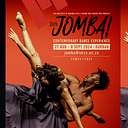‘Voices from the Fringes of Africa’
By Ruth Asidi
17:57, with my phone perfectly propped up against an empty mug, the countdown on the screen draws to an end. Fringe! The 8th night of Digital JOMBA! Contemporary Dance Experience presents an open platform where eight selected dance makers (Robert Ssempijja, Sabelo Cele, Pavishen Paideya, Phumlani Life Mndebele, Jena Woodroffe, Kaldi Makutike, Sifiso E. Kweyama and Julie Veronirina Iarisoa), from the continent of Africa are given the opportunity to showcase their digital dance films. As these defiant emerging and established artists set to take on our virtual stage, only three winning films will be shortlisted.
Gloved fingers walk along a brick wall. Masked, the dancer’s body leans upon it. Red roofed houses tightly packed together. An alleyway so narrow, only one body could pass at any one time. As part of the Digital JOMBA! Fringe, first prize winner Robert Ssempijja, twists and contorts his body in ways that brings our attention to the limited space and reality that his and other bodies live in. In this Covid-stricken world where social distancing, working from home and the regular washing of hands is too easily thrown around as a ‘one fit all’ solution, THE MYTH OF SELF ISOLATION cries out for the intimate living conditions in Ugandan communities. Such privilege, not all can afford.
White chains, white paint contrasting deep dark-brown skin. Shackling, restraining, and yet the body continues to wrestle. Sabelo Cele’s (Rea)-Leaze Chains, nominated second prized winner of the Fringe Programme, takes us on a journey from a black and white imprisonned indoor space to that of colour and openness, outdoor by the sea. An appreciation of colour arises when presented with it, along with the open-air as we watch Cele walk towards the sea, footprints left behind.
Exploring the theme of individuality and a refusal to be cramped into boxes of literal and metaphorical kinds, Pavishen Paideya’s AHAM- I Am wins third place on the JOMBA! Fringe stage. Fusing the traditional Indian classical dance form Bharatanatyam with contemporary dance expressions, what starts off as an orderly group composition breaks out into several duos and solos, shining light on themes of effeminacy, gender based violence and discrimination. Precise hand gestures follow the release of floor work techniques, as AHAM-I Am thoughtfully pokes at the neatly drawn boundaries that seem to leave no room for those who choose differently.
And different indeed this night proves to be. The rapid rippling, lizard-like movements of Thirst, pulsating against the tall grey walls of the container within which the body is held. Fingers tensely spread apart. Screams that seem to produce no sound. Bare-skin, muscles taut, the body resists.
Resist, the body does. Restless, seeking comfort. Rigid, staccato movements reveal an internal battle. Limbs extend soflty, and yet gentleness retreats once again. Balanced isolation, a desire to ascend with the dancer arises, as we are left watching her spinning shadow on the ground.
Isolating different body parts, the dancer’s head is covered with black balloons. An exploration between men, dead air and therapy. Therapy Session, captures the steamy sensation you get from breathing in your own air. Enclosed, even whilst being outdoors. Bodies fade into oblivion. When finally the balloons disappear, the dancer’s body collapses.
A body bent forward over a basin, water pours onto the back of its head, yielding, surrendering to the fall of water on skin. With grace and embracive arms, ‘Like a river fill-up’, captures the outpouring of movement from a confined hollow-squared window.
The continuation of movement, as depicted by Julie Veronirina Iarisoa against the changing backdrop of different workplaces encapsulates the ongoing-ness of life. If anyone were to ask what one did during these time of crisis ‘…And during that time I was dancing…’ she’d reply.
